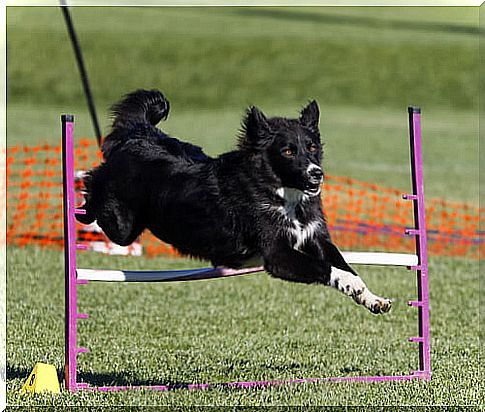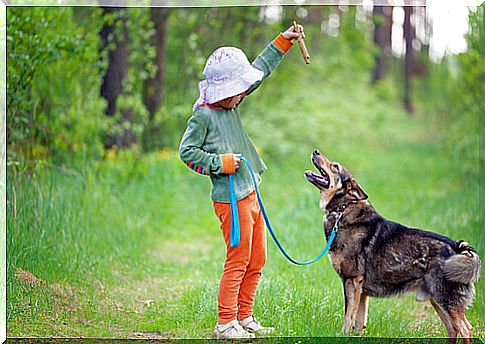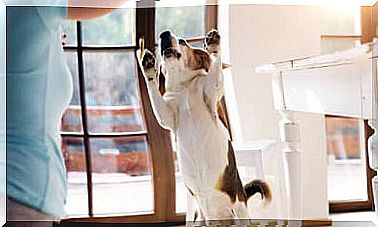Training During Quarantine: Keys For Tutors

Training during quarantine can be a beneficial activity in the long term, if the mentor knows how to take advantage of it from the beginning. Are you interested in knowing the keys to achieve it? Then we will comment on all of them.
As we have been saying, quarantine can be a good time to improve your relationship with pets. To achieve this, it takes a little more than games and love.
Training can help you improve communication with your pet, and it will also help you better understand various issues. And of course, it will always provide some entertainment.
Training or education?
Before proceeding further, it is important to note that dog education and training are different concepts. Let’s look at some of the reasons below.
- Training consists of teaching a dog skills, what we call ‘tricks’. It is about encouraging behaviors based on obedience. Through positive reinforcement, a dog can learn to lie down, sit, paw, stay still or turn, among others.
- Canine education is based on the dog being able to manage all the situations that his usual environment presents him with. This translates into the pet’s ability to walk normally, have peaceful encounters with other dogs, not feel anxiety when staying home alone, or that it can be with other people in the company or absence of the guardian.
If your dog has a problem of this second type or is aggressive, has phobias or other similar behaviors, you should consult a professional canine educator.

How to train a dog?
Just as there are professional educators, there are also canine trainers, there are even professionals who know both techniques.
For canine learning, the best method is positive reinforcement, rewarded or reinforced actions tend to be repeated and reinforcement is usually the animal’s motivation to do it. This prize does not have to be only food: caresses, attention or toys can also be good motivations.
By training we can get many benefits beyond obedience. These exercises will facilitate communication with the dog in all kinds of situations, and various positive aspects will be reinforced:
- Basic obedience. Learning basic commands such as “sit” or “stay” are essential to know where to be in a place and to improve the animal’s self-control. Others such as “go glued” serve for the pet to walk by our side, and for example “come” reinforces that it comes to the call.
- Improved bond with the animal. Training during quarantine (or any other time) can bring us closer to the dog, understand it better, know its weaknesses, what it likes, when it feels comfortable … In short, it can be a communication tool between pet and guardian.
- Involvement of the entire family nucleus. Positive reinforcement can be done by anyone in the family, and even the little ones can learn to reinforce the dog’s good deeds and get involved in caring for the pet. In times of lack of external stimuli, these types of practices are very beneficial for children.

Training during quarantine
Learning also requires effort on the part of the animal, and the energy accumulated after a day of short walks and prolonged stay at home can be used at this time. Still, the quarantine training process requires some clear ideas from the tutor.
1. Be patient
Training takes time and practice. Don’t despair if your dog doesn’t do what you want on the first try. Animals are autonomous and have their own desires and feelings, something that we do not have to forget.
Dogs can interpret facial expressions and recognize human emotions. Therefore, to help them learn, it is best to convey a feeling of firmness and tranquility. It is useless to yell, scold, and much less come to blows, with that you only manage to create a bad experience associated with training.
2. Make the most of the best moment
The speed of obedience learning depends on each type of dog. There are breeds with greater ease for this, and the mental state in which the animal is at that moment is also very important.
Both parties, both the tutor and the pets, have to be open to interaction. Forcing a tired dog to learn will be a frustrating process for both of you.
3. Positive reinforcement
Reinforce the good deeds with something that motivates your dog enough to want to get it but does not cause an obsession that completely distracts him at the time. Food is the most widespread type of positive reinforcement, but petting, playing games, or walks will also make the pet associate learning with rewards.
4. Use body language
The language of signs and gestures is very visual for dogs, which although they can understand words, it is easier for them to associate activities with gestures. In fact, there are specific gestures that make it easier to learn the different commands (sit, stay, come, look, lie down…) Over time you will see that they execute the action by the gesture before saying the command aloud.

Patience and respect, two important keys
As you may have seen, the world of dog training is simple but requires an understanding of certain rules and concepts. Remember that throughout the process it is essential to know how to respect both the needs of the animal and its own space, because the idea is that it learns and advances, not that it feels punished.
If both of you are open to healthy interaction, training during quarantine will be a very beneficial process.









